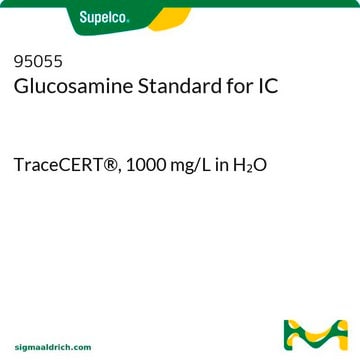Wichtige Dokumente
G5509
D-Glucosamine 6-phosphate
≥98% (TLC)
Synonym(e):
2-Amino-2-deoxyglucose 6-phosphate
About This Item
Empfohlene Produkte
Biologische Quelle
natural (inorganic)
Qualitätsniveau
Assay
≥98% (TLC)
Form
powder
Methode(n)
thin layer chromatography (TLC): suitable
Verunreinigungen
≤10% water (Karl Fischer)
Farbe
white
Löslichkeit
water: 50 mg/mL, clear to hazy, colorless to almost colorless
Lagertemp.
−20°C
SMILES String
NC(C=O)C(O)C(O)C(O)COP(O)(O)=O
InChI
1S/C6H14NO8P/c7-3(1-8)5(10)6(11)4(9)2-15-16(12,13)14/h1,3-6,9-11H,2,7H2,(H2,12,13,14)
InChIKey
AEJSSXDYDSUOOZ-UHFFFAOYSA-N
Allgemeine Beschreibung
Verlinkung
Sonstige Hinweise
Lagerklassenschlüssel
11 - Combustible Solids
WGK
WGK 3
Flammpunkt (°F)
Not applicable
Flammpunkt (°C)
Not applicable
Persönliche Schutzausrüstung
Eyeshields, Gloves, type N95 (US)
Hier finden Sie alle aktuellen Versionen:
Analysenzertifikate (COA)
Die passende Version wird nicht angezeigt?
Wenn Sie eine bestimmte Version benötigen, können Sie anhand der Lot- oder Chargennummer nach einem spezifischen Zertifikat suchen.
Besitzen Sie dieses Produkt bereits?
In der Dokumentenbibliothek finden Sie die Dokumentation zu den Produkten, die Sie kürzlich erworben haben.
Kunden haben sich ebenfalls angesehen
Active Filters
Unser Team von Wissenschaftlern verfügt über Erfahrung in allen Forschungsbereichen einschließlich Life Science, Materialwissenschaften, chemischer Synthese, Chromatographie, Analytik und vielen mehr..
Setzen Sie sich mit dem technischen Dienst in Verbindung.










